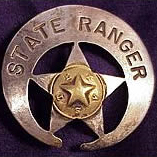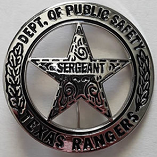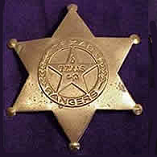Buyer Beware! Avoid Replicas, Fake, and Fantasy Badges
 The chances of finding an authentic early (pre-1935) Texas Ranger badge is the same as winning the lottery. Some badges for sale found on web sites, auctions, and gun shows are truthfully advertised as replicas or fantasy badges, but others are carefully crafted to mislead collectors and enthusiasts. We hope the following information helps you to make wise purchases.
The chances of finding an authentic early (pre-1935) Texas Ranger badge is the same as winning the lottery. Some badges for sale found on web sites, auctions, and gun shows are truthfully advertised as replicas or fantasy badges, but others are carefully crafted to mislead collectors and enthusiasts. We hope the following information helps you to make wise purchases.
The only ironclad evidence for an authentic pre-1935 Texas Ranger badge is an authentic document of verified chain-of-ownership from a specific ranger to present day. This may seem like an impossible standard, but consider that very few rangers wore badges between the 1870s and 1935. Prior to 1935 a ranger could buy and wear any type of badge they chose, ordered from jewelers, gunsmiths or presented to them from grateful citizens. The lack of standardization facilitates fraudulent activity.
Things to watch out for:
- Flourish words in descriptions like "vintage", "obsolete", "antique", etc.
- Statements of hearsay "... a friend of my grandfather..."
- Opinions from unverified experts
- Vague references to museums, estates, collectors, etc.
Things to keep in mind:
 Untrustworthy sellers hide behind PO Boxes, email aliases, and false/temporary phone numbers
Untrustworthy sellers hide behind PO Boxes, email aliases, and false/temporary phone numbers- Dirt, patina, imperfections, and evidence of wear are easy to fake
- Being made of a quality metal, like silver, does not make it authentic
- Many fake/replica/fantasy badges have the Mexican coin impression cast on the back
- The six-pointed star was never used by the Texas Rangers
- To date, there is no authenticated badge with "Frontier Battalion" or "F.B." on them
The 1987 "Badge Law"
 In 1987 the Texas Legislature enacted Texas Government Code Sec. 411.017 making it illegal to manufacture, sell or possess a real Texas Ranger badge or replica of the current design in the State of Texas. To do so is a Class A misdemeanor punishable by up to a year in jail and a fine of up to $4,000.
In 1987 the Texas Legislature enacted Texas Government Code Sec. 411.017 making it illegal to manufacture, sell or possess a real Texas Ranger badge or replica of the current design in the State of Texas. To do so is a Class A misdemeanor punishable by up to a year in jail and a fine of up to $4,000.
Replicas are deemed to be in violation if they are “deceptively similar” to the current badge, meaning "a reasonable person would presume that it was prescribed by the department” and has the inscriptions “Texas Department of Public Safety”, “Department of Public Safety”, or “Texas Rangers”.
Wearing a replica of the current-design Texas Ranger badge can be considered impersonating a police officer, a Class B misdemeanor punishable by up to 180 days in jail and a fine of up to $2,000.
- Beware of illegal replicas being sold by auctions or fundraisers who may not be aware of this law.
- Other states and countries have reciprocal laws preventing trade, possession or wearing of law enforcement insignia/credentials.
- Shipping current-design Texas Ranger badges or replicas by US mail or commercial carrier is a separate Federal offense.
Examples of Illegal Replica Badges

Glossary
 Fantasy Badges - bear little resemblance to any authentic badge. They are made of metal and may incorporate design elements from real Ranger badges, military insignia, and other police badges as well as the designer’s flights of fancy.
Fantasy Badges - bear little resemblance to any authentic badge. They are made of metal and may incorporate design elements from real Ranger badges, military insignia, and other police badges as well as the designer’s flights of fancy.
 Replica - an accurate or inaccurate copy of a real badge. A replica may violate the badge statute, but it does not constitute fraud unless it is advertised or sold with the statement or implication it is authentic.
Replica - an accurate or inaccurate copy of a real badge. A replica may violate the badge statute, but it does not constitute fraud unless it is advertised or sold with the statement or implication it is authentic.
 Toy Badges - have been made for children since at least the 1930s and many are considered collectibles. They are usually made of metal-colored plastic, or "pot-medal" and are hard to confuse with the real thing.
Toy Badges - have been made for children since at least the 1930s and many are considered collectibles. They are usually made of metal-colored plastic, or "pot-medal" and are hard to confuse with the real thing.